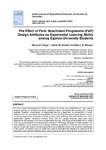The Effect of Farm Attachment Programme (FAP) Design Attributes on Experiential Learning Ability among Egerton University Students

View/
Date
2021Author
Chege, Nancy W.
Ombati, Justus M.
Mungai, Nancy W.
Metadata
Show full item recordAbstract
The Farm attachment programme (FAP) of Egerton University was established six years ago to
promote learning by “reflection on doing” commonly known as Experiential Learning (EL), among
students. However, effectiveness of experiential learning is dependent on possession of certain
abilities known as experiential learning abilities (ELAs) including willingness to get actively involved
in learning experiences and ability to reflect, analyze, solve problems and make decisions on learnt
experiences. Egerton University students’ ELAs and FAP design attributes have never been
assessed for the purpose of enhancing experiential learning. This study aimed at determining levels
ELAs among the students and assessing the effects of FAP design attributes on these abilities. The
study adopted a cross sectional survey design targeting a population of 600 students and their host
farmers. Systematic random sampling procedure was employed to select 102 students to participate
in the survey. A 5-point continuum scale was used to rate gathered indicators to measure ELAs.
Descriptive and inferential statistics were used to analyze the data. Students ELA Levels were found
to be low (M= 2.79, SD = 0.51). The following FAP design attributes were found to have a significant
effect on ELAs: Students’ prior agricultural knowledge levels (F (2.94) = 3.816), P =0.02) with an
effect size of 8%, gender (F (1,96) = 4.312, P = .037), with an effect size of 4.4% Students study
programme departments, (F (6,91) =2.652, =.011), with an effect size of 16.4%, Year of attachment
(F (3,94) =4.206, P= .008), with an effect size of 11.8%. Among the host farmer attributes, income
level of the farmer was found to have a significant effect on students’ ELAs (F (2, 94) =3.920,
p=.026). FAP structure and implementation had significant effects on experiential learning ability (F
(2,94) =4.309) P= .016; F (2,94) =8.51, P <.001) and effect sizes of 8.4% and 13.9% respectively.
The results showed that the ELA levels were low among students and certain FAP design attributes
had a significant (at 5% level of significance) effect on the learning abilities.
